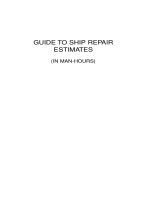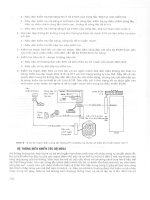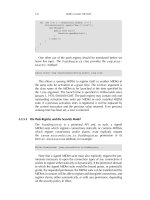Guide to Ship Repair Estimates Episode 4 ppsx
Bạn đang xem bản rút gọn của tài liệu. Xem và tải ngay bản đầy đủ của tài liệu tại đây (63.57 KB, 10 trang )
Current density of material in mA/m
2
=
Information from manufacturer (between 10 and 30, say 20)
Design Life =
Number of years between dry dockings (e.g. 3)
K =
Number of hours in 1 year = 8760
Capacity of material (amp hours / kg) =
Information from manufacturer (781 is common)
Using the above formula, it is a simple matter to create a spreadsheet
to determine the weight of zinc anodes.
Input the data into the table and use the formula to determine
the weight of zinc anodes for the period required.
Drydocking works 21
ch001.qxd 28/7/00 11:36 am Page 21
Sea chests
Table 2.11 Sea chests and strainers
Opening up of sea chests by removing ship side strainers, cleaning
and painting with owner’s paints, as per hull treatment specification.
Assuming single grid per chest.
Surface Area m
2
Man-hours
Below 0.3 12
0.3–1 20
Above 1 30
Additional charge per extra grid 5
Docking plugs
Allowance made of 1 man-hour for removing and later refitting of
each tank drain plug using ship’s spanner, assuming no locking
devices fitted and excluding all removals for access and repairs to
threads.
22 Guide to Ship Repair Estimates (in Man-hours)
ch001.qxd 28/7/00 11:36 am Page 22
Drydocking works 23
Valves
Table 2.12 Sea valves
Opening up hand-operated, globe and gate valve for in situ overhaul
by disconnecting and removing cover, spindle and gland, cleaning all
exposed parts, hand grinding of globe valve, light hand scraping of
gate valve, testing bedding, painting internal exposed areas and
reassembling with new cover joint and repacking gland with conven-
tional soft packing.
(a) Butterfly valve: remove, clean, check, testing bedding of seals,
paint internal exposed areas and refit; excluding operating gear.
(b) Checking and cleaning large butterfly valves through the sea
chest.
Valve bore Globe Gate (a) Butterfly (b) Butterfly
(mm) valve valve valve valve
>50 4 4.5 6 –
100 6 7 8.5 –
150 8 9 11.5 –
200 10 11 14 –
250 13 14 18 –
300 16 17 22 –
350 20 21 26 13
400 23 24 29 14
450 26 28 33 14.5
500 30 31 37 15
550 34 35 42 16
600 37 39 46 16.5
650 41 43 51 17
700 44 47 56 18
750 47 49 60 19
800 50 53 66 20
900 57 60 81 22
1000 65 68 100 24
1100 73 77 106 25
1200 84 88 113 27
1300 95 100 120 30
ch001.qxd 28/7/00 11:36 am Page 23
24 Guide to Ship Repair Estimates (in Man-hours)
Notes:
Valves in pump rooms, additional 15%.
Valve in cofferdams and inside tanks, additional 20%.
Removals for access not included.
Staging for access not included.
Removing valve ashore to workshop for the above type of overhaul requires
special consideration, dependent upon size. Valves below 20 kg in weight
can be assessed as double the in situ rate. Above this requires rigging and
cranage input, which should be assessed separately.
Table 2.13 Ship side storm valves
Opening up ship side storm valve for in situ overhaul, by disconnect-
ing and removing cover, spindle and gland, cleaning all exposed
parts, testing bedding, painting internal exposed areas and reassem-
bling with new cover joint and repacking external gland with conven-
tional soft packing.
Dia. (mm) Man-hours per valve
50 9
75 10
100 12
125 14
150 16
200 17
Note: Disconnecting and removing ashore for above overhaul and later refit-
ment; double the above rate.
ch001.qxd 28/7/00 11:36 am Page 24
Fenders
Table 2.14 Hollow fenders in half schedule 80 steel pipe
Fendering formed by cutting steel pipe into two halves.
Cropping existing external damaged fendering, hand grinding
remaining edges and preparing remaining flat hull plating for
welding.
Supplying and fitting new fendering in half-round standard schedule
80 steel pipe and full fillet welding fender in place.
Including erection of staging for access and later dismantling.
Exclusions:
All hull preparation and painting of the steelworks in way of the
repairs.
Man-hours per metre
Pipe dia. (mm) Straight run of fender Curved fender at corners
200 20 30
250 22 32
300 24 34
350 26 36
Note: The above figures are for split steel pipe only. For other shapes, then
steel fabrication tariffs will be applicable, based upon steel weights.
Drydocking works 25
ch001.qxd 28/7/00 11:36 am Page 25
Anchors and cables
Table 2.15 Anchor cables (per side)
Ranging out for examination and later restowing
Cleaning by high-pressure jetwash or grit sweeping
Calibration of every 20th link and recording
Marking shots with white paint
Painting cables with owner’s supplied bitumastic paint
Opening ‘Kenter’-type shackle and later closing
Disconnect first length of cable and transferring to end
Changing cable end for end.
Small vessels
Cable dia. (mm) Man-hours (per side)
< 25 70
25–50 90
Large cargo vessels and oil tankers
DWT Man-hours (per side)
< 20,000 100
20,000–50,000 130
50,000–100,000 140
100,000–200,000 200
200,000–300,000 250
over 300
,000 270
26 Guide to Ship Repair Estimates (in Man-hours)
ch001.qxd 28/7/00 11:36 am Page 26
Chain lockers
Table 2.16 Chain lockers (per side)
Opening up, removing dry dirt and debris, handscaling, cleaning and
painting one coat bitumastic. Closing up on completion.
Removing internal floor plates, or grating, cleaning, painting and
refitting.
Small vessels
Cable dia. (mm) Man-hours (per side)
< 25 75
25–50 90
Large cargo vessels and oil tankers
DWT Man-hours (per side)
< 20,000 100
20,000–50,000 130
50
,000–100,000 140
100
,000–200,000 200
200,000–300,000 250
over 300,000 270
Note: Removal of sludge will be charged extra per m
3
.
Drydocking works 27
ch001.qxd 28/7/00 11:36 am Page 27
Staging
This item is usually charged within a particular job. When included
within the charge of a job, that job price is increased accordingly.
However, to assist estimating, it can be based on cubic metres of air
space covered. A minimum charge of approximately 8 m
3
will be
made.
The figures stated in Table 2.17 cover for erection and later dis-
mantling and removal of external staging. For internal staging, inside
tanks, engine rooms, etc. a third column is shown.
Table 2.17 Erection of tubular steel scaffolding, complete with all
around guard rails, staging planks and access ladders
Man-hours/m
3
m
3
External Internal
Up to 10 3 5
10–100 2.5 4
100–> 2 3
28 Guide to Ship Repair Estimates (in Man-hours)
ch001.qxd 28/7/00 11:36 am Page 28
3 Steel works
Steel repairs
Applicable to Grade A shipbuilding steels
●
Marking off the external area of hull plating on vertical side up to
a height of 2 metres, cropping by hand burning and removal of all
cropped plating.
●
Dressing and preparation of plate edges of remaining external
plating.
●
Dressing and preparation of remaining internal structure.
●
Supply and preparation of new flat steel plating, blasting to Sa2.5
and applying one coat of owner’s supplied, holding primer.
●
Transportation of new plate to vessel, fitting up, wedging in posi-
tion, minor fairing and dressing of plate edges in the immediate
vicinity, applying first runs of welding on one side, back gouging
from other side and finally filling and capping to give fully fin-
ished weld.
Included in the tariff are:
●
Only the work to the steelwork mentioned.
●
Cleaning and chipping paint in the immediate vicinity of the
repair area to facilitate hot cutting work.
●
Cranage and transportation of the new and removed steelwork.
Exclusions:
●
Staging for access. For staging charges see relevant section.
●
All removals for access and later refitments.
●
Tank cleaning and gas freeing.
●
Cleaning in way of repairs other than the immediate vicinity as
noted above.
Steel works 29
ch001.qxd 28/7/00 11:36 am Page 29
●
All final tests to repairs.
●
Fairing of adjacent plates except as minor in the immediate vicin-
ity as noted above.
Man-hours are per tonne of finished dimensions. The rates shown are
for large quantities of steel renewals. The limit will be given by the
shipyard and is dependent upon the size of the repair yard and the
vessel. Assume the limit to be approximately 5 metric tonnes.
Shipowner’s superintendents should be aware of the methods
used by the shipyards of calculating steel weights, and this is illus-
trated below.
Flat steel plate
●
For flat steel plates, measure the length in metres, the width in
metres and the plate thickness in millimetres.
●
Take the specific gravity of the material. For steel, the SG is 7.84,
but it is common practice for estimators to use 8.
●
To calculate the weight of the plate in kg:
Multiply L × W × Th × SG
For example:
Plate no. L (m) W (m) Th (mm) SG Wt (kg)
1234 1 1 10 8 80
FLAT PLATE
L × W × Th × SG = Weight in kg
ANGLE
L × (W
1
+ W
2
) × Th × SG = Weight in kg
30 Guide to Ship Repair Estimates (in Man-hours)
ch001.qxd 28/7/00 11:36 am Page 30









